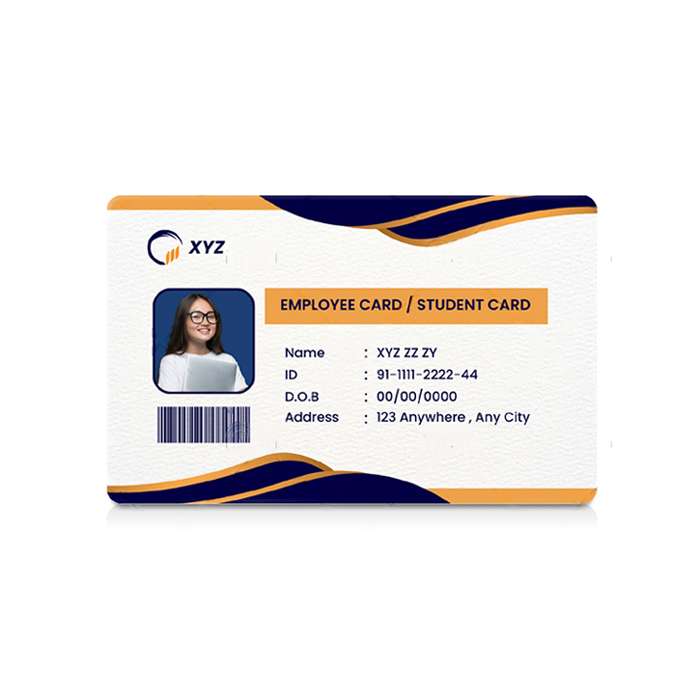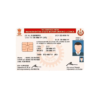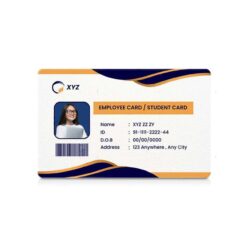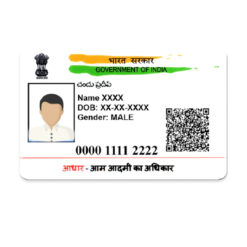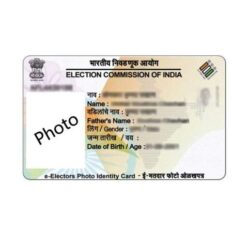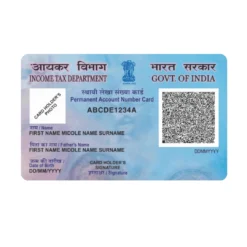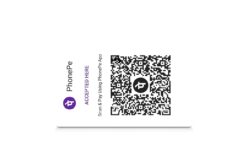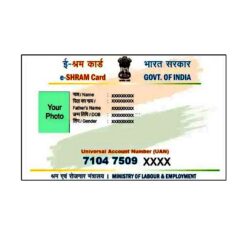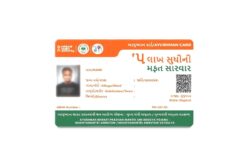PVC ID Card Printing Online
₹100.00 Original price was: ₹100.00.₹50.00Current price is: ₹50.00.
PVC ID Card Printing Explore the essential details of PVC ID card printing technology, benefits, types of cards, security features, and FAQs in this comprehensive guide.
PVC ID Card Printing Online Here

| PVC ID Card Printing Product Info: A Complete Guide | Introduction: Understanding PVC ID Cards & Printing Technology |
| What Are PVC ID Cards? | What is PVC Material? |
| Types of PVC ID Cards | Standard PVC Cards Magnetic Stripe Cards Smart Cards & RFID Cards Dual-Sided PVC Cards |
| PVC ID Card Printing Technology | Dye-Sublimation Printing Retransfer Printing Thermal Printing |
| Benefits of PVC ID Cards | Durability and Longevity Water and Scratch Resistance Customization Options |
| Key Features of PVC ID Cards | Full-Color Printing Magnetic Stripes Embedded Smart Chips Barcodes & QR Codes |
| How PVC ID Card Printing Works | Designing the Card Encoding Data Printing Process Lamination for Durability |
| PVC ID Card Applications | Employee Identification Membership Cards Access Control Event Badges |
| Security Features of PVC ID Cards | Holograms and UV Printing Microtext and Anti-Counterfeiting Measures |
| How to Customize PVC ID Cards | Logo and Branding Personalized Information Variable Data Printing |
| PVC ID Card Printing Process Explained | Card Design Software Printer Setup and Configuration Post-Printing Processes |
| Cost of PVC ID Card Printing | Factors Affecting Price Bulk Orders vs. Single Orders |
| PVC ID Card Printers: Best Options | Top Brands in the Market Features to Look for in a PVC Printer |
| PVC Card Maintenance and Durability | How to Care for Your PVC Cards Longevity of Printed Cards |
| Future Trends in PVC ID Card Printing | Contactless Cards and Smart Cards Sustainability in Card Printing |
| FAQs About PVC ID Card Printing | What is the typical lifespan of PVC ID cards? Can I print a PVC card myself? How long does it take to print PVC cards? Are PVC cards eco-friendly? What is the difference between single-sided and dual-sided cards? How do I store my PVC cards for long-term use? |
| Conclusion | Key Takeaways on PVC ID Card Printing |
PVC ID Card Printing Product Info: A Complete Guide

PVC (Polyvinyl Chloride) ID cards are a widely used solution for identification, membership, and access control. This guide covers everything you need to know about PVC ID card printing, from the technology behind it to the various applications and security features. Whether you’re looking to implement an ID card system in your organization or simply curious about the process, this comprehensive article will give you all the details.
What Are PVC ID Cards?

What is PVC Material?
PVC material is a robust, flexible plastic commonly used in various applications, including credit cards, employee IDs, and membership cards. It’s known for its durability, resistance to wear and tear, and ease of customization. PVC cards are typically 0.76mm thick (standard size CR-80) and can be printed with high-quality designs that last for years.
Types of PVC ID Cards
Standard PVC Cards
The most common type of PVC card, these are single-sided cards that can be printed with basic details like names, logos, and photos.
Magnetic Stripe Cards
Magnetic stripe cards feature a stripe on the back that can store data. These are widely used for access control, banking, and membership systems.
Smart Cards & RFID Cards
These cards contain embedded microchips or radio-frequency identification (RFID) tags that allow for contactless interaction. They are often used in secure environments for access control.
Dual-Sided PVC Cards
Dual-sided cards offer more space for information, allowing printing on both the front and back. These are ideal for organizations that require detailed identification or additional functionality.
PVC ID Card Printing Technology

Dye-Sublimation Printing
Dye-sublimation printing is the most common method for printing PVC ID cards. The process uses heat to transfer dye onto the card’s surface, producing vibrant, full-color images and text.
Retransfer Printing
This method prints the image onto a transfer film first, then heat bonds it to the card. It offers higher print quality and full edge-to-edge coverage, making it ideal for high-end applications.
Thermal Printing
Thermal printing uses heat to imprint text, barcodes, or other simple graphics on the card. This method is commonly used for adding information to pre-printed PVC cards, such as names or access codes.
Benefits of PVC ID Cards
Durability and Longevity
PVC cards are highly durable, resistant to scratches, and capable of withstanding wear and tear over time, making them ideal for long-term use in demanding environments.
Water and Scratch Resistance
Unlike paper-based cards, PVC cards are waterproof and scratch-resistant, which makes them more practical for daily handling, especially in outdoor or industrial settings.
Customization Options
From full-color printing to embedding security features like holograms, PVC cards can be fully customized to fit your needs, ensuring they are both functional and visually appealing.
Key Features of PVC ID Cards
Full-Color Printing
PVC ID cards can be printed in vibrant, full-color designs, making them visually appealing and professional. Ideal for branding and clear identification.
Magnetic Stripes
Magnetic stripe cards are essential for tracking and access control. They store data and can be easily encoded during the printing process.
Embedded Smart Chips
Smart chips can be embedded into PVC cards for contactless access control or storing personal information securely. This is essential for high-security applications like banking or corporate offices.
Barcodes & QR Codes
Barcodes and QR codes are commonly used for tracking or linking the ID to specific digital information. These codes can be printed directly onto the card.
How PVC ID Card Printing Works
Designing the Card
The design process involves choosing colors, fonts, logos, and placing essential data like names and photos. Graphic design software is used to create the layout, ensuring everything fits within the card’s dimensions.
Encoding Data
For cards with magnetic stripes, smart chips, or barcodes, the next step involves encoding them with the necessary data. This ensures that each card has the correct information for its intended function.
Printing Process
Once the design and encoding are complete, the actual printing begins. This can be done using various printing methods, including dye-sublimation and thermal printing.
Lamination for Durability
After printing, the cards can be laminated with a protective overlay. This enhances durability and protects the printed information from fading.
PVC ID Card Applications
Employee Identification
PVC ID cards are commonly used as employee IDs in businesses, providing secure access to buildings and identifying individuals quickly.
Membership Cards
Organizations like gyms, clubs, and libraries issue PVC membership cards, providing a secure and convenient way to track members.
Access Control
PVC cards are also used in access control systems, allowing individuals to gain access to restricted areas based on their encoded data.
Event Badges
For events, PVC cards can be used as badges to identify attendees, speakers, or volunteers, often including features like barcodes or QR codes for quick entry.
Security Features of PVC ID Cards
Holograms and UV Printing
Holograms and UV printing are security features that make cards difficult to duplicate, ensuring authenticity and preventing fraud.
Microtext and Anti-Counterfeiting Measures
Microtext involves printing tiny text that is not visible to the naked eye, which adds an additional layer of security.
How to Customize PVC ID Cards
Logo and Branding
You can add your company’s logo, brand colors, and custom designs to the cards, ensuring they represent your brand accurately.
Personalized Information
Each card can be personalized with details such as the user’s name, ID number, department, and more.
Variable Data Printing
For large organizations, variable data printing allows the customization of each card with unique information, including barcodes and QR codes.
PVC ID Card Printing Process Explained
Card Design Software
Design software such as Cardpresso or Zebra CardStudio is used to create the card’s design, including layout and data integration.
Printer Setup and Configuration
The PVC ID card printer is configured for the specific print job, whether it’s single-sided or dual-sided, with magnetic stripe encoding or smart chip programming.
Post-Printing Processes
Once the cards are printed, they are tested for quality, laminated if necessary, and packaged for distribution.
Cost of PVC ID Card Printing
Factors Affecting Price
The cost of printing PVC ID cards can vary depending on factors like the number of cards, customization level, and security features. Bulk orders often reduce the cost per card.
Bulk Orders vs. Single Orders
Ordering in bulk generally results in a lower per-card cost, which can be beneficial for businesses with a large number of employees or members.
PVC ID Card Printers: Best Options
Top Brands in the Market
Popular brands for PVC card printers include Zebra, Fargo, and Evolis, offering reliable and high-quality printers for all types of PVC cards.
Features to Look for in a PVC Printer
When purchasing a PVC printer, consider factors like print resolution, speed, the ability to print on both sides, and the availability of encoding options.
PVC Card Maintenance and Durability
How to Care for Your PVC Cards
To extend the life of your PVC cards, store them in a cool, dry place, away from direct sunlight, and avoid bending or damaging the cards.
Longevity of Printed Cards
With proper care, PVC cards can last for years, making them an excellent long-term solution for identification and access control.
Future Trends in PVC ID Card Printing
Contactless Cards and Smart Cards
The future of PVC ID cards lies in contactless technology and embedded smart chips, which enable secure and convenient access.
Sustainability in Card Printing
As sustainability becomes a priority, the industry is exploring eco-friendly printing options and the use of recyclable materials in card production.
FAQs About PVC ID Card Printing
What is the typical lifespan of PVC ID cards?
PVC cards can last anywhere from 3 to 5 years, depending on the level of use and environmental conditions.
Can I print a PVC card myself?
Yes, you can use a specialized PVC card printer to print your cards, but professional printing services often offer higher quality and more advanced features.
How long does it take to print PVC cards?
The printing process typically takes a few minutes per card, with batch printing reducing the overall time for larger orders.
Are PVC cards eco-friendly?
While PVC is durable, it is not biodegradable. However, there are eco-friendly options available, such as recyclable PVC cards.
What is the difference between single-sided and dual-sided cards?
Single-sided cards have print on only one side, while dual-sided cards offer printing on both sides for more space and information.
How do I store my PVC cards for long-term use?
Store PVC cards in a cool, dry place, away from direct sunlight or extreme temperatures, to maintain their integrity.
Conclusion
PVC ID card printing offers a flexible, durable, and customizable solution for a wide range of identification and access control applications. By understanding the types, features, and processes involved in PVC card printing, businesses and organizations can ensure they choose the right solution for their needs.

